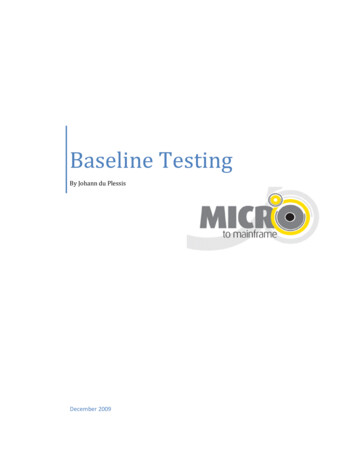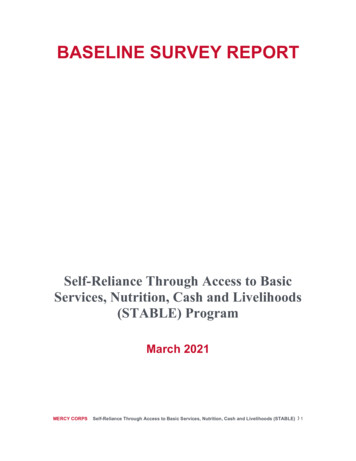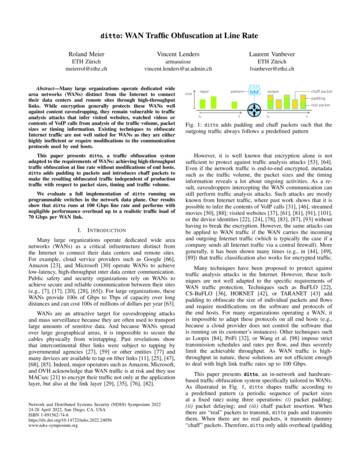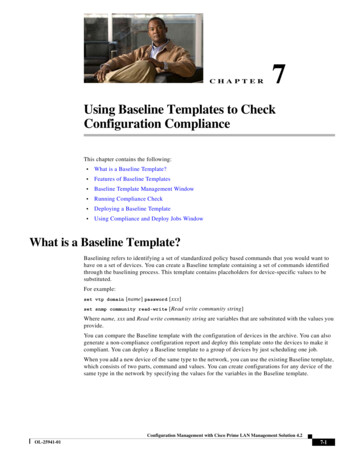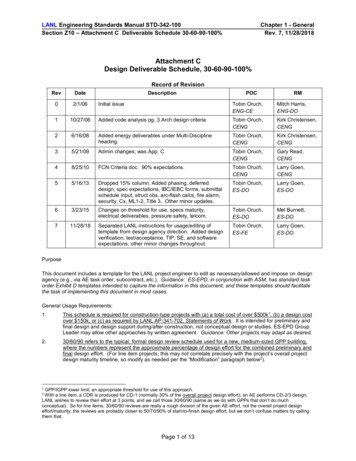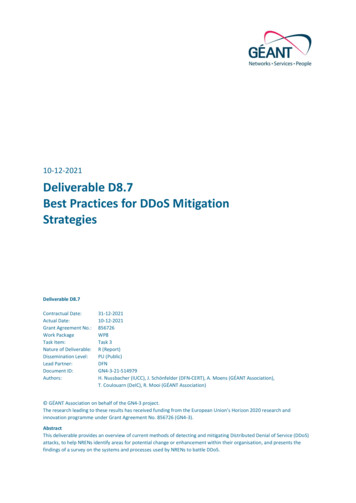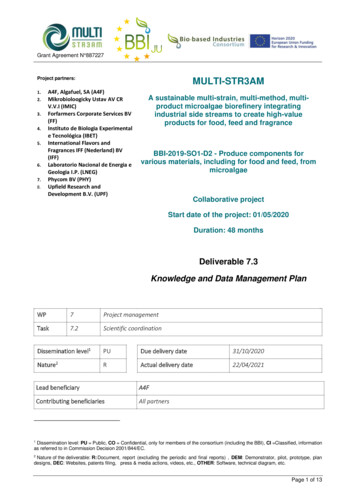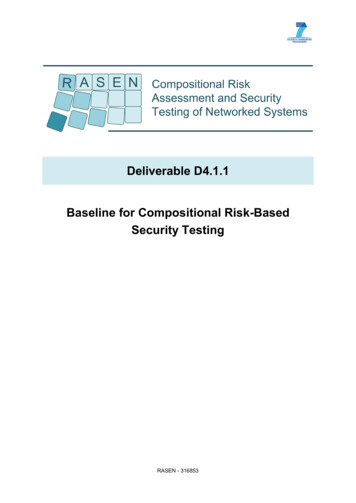
Transcription
Deliverable D4.1.1Baseline for Compositional Risk-BasedSecurity TestingRASEN - 316853
Project title:RASENProject number:316853Call identifier:FP7-ICT-2011-8Objective:ICT-8-1.4 Trustworthy ICTFunding scheme:STREP – Small or medium scale focused research projectWork package:WP4Deliverable number:D4.1.1Nature of deliverable:ReportDissemination level:PUInternal version number:1.0Contractual delivery date:2013-01-31Actual delivery date:2013-01-31Responsible partner:SmartestingRASEN - 316853Page 2 / 43
ContributorsEditor(s)Fabien Peureux (SMA)Contributor(s)Jürgen Großmann (FOKUS), Bruno Legeard (SMA), Fabien Peureux (SMA),Martin Schneider (FOKUS), Fredrik Seehusen (SINTEF)Quality assuror(s)Arthur Molnar (IW), Bjørnar Solhaug (SINTEF)Version historyVersionDateDescription0.112-11-09TOC proposition0.212-12-17Preliminary draft of the deliverable0.313-01-07Updates of Section 2 & 30.413-01-11Updates of Section 2 & 50.513-01-16Updates of Section 4 & 50.613-01-21Final updates for all document – ready for internal review1.013-01-31Final versionAbstractWork package 4 will develop a framework for security testing guided by risk assessment andcompositional analysis. This framework, starting from security test patterns and test generationmodels, aims to propose a compositional security testing approach able to deal with large scalenetworks systems. This report provides a state of the art of methodologies involved to reach this goal,respectively, risk-related security testing approaches, such as security testing metrics and testingapproaches for large-scale networked systems. The report finally provides the RASEN baseline forcompositional risk-based security testing. The baseline defines the basis for the development work tobe completed during the project.KeywordsSecurity testing, risk-based security testing, fuzzing on security models, security testing metrics,large-scale networked systemsRASEN - 316853Page 3 / 43
Executive SummaryThe overall objective of RASEN WP4 is to develop techniques for how to use risk assessment asguidance and basis for security testing, and to develop an approach that supports a systematicaggregation of security testing results. The objective includes the development of a tool-basedintegrated process for guiding security testing deployment by means of reasonable risk coverage andprobability metrics.The purpose of this document is twofold. First, we give an overview of the state of the art that isrelevant for the WP4 research objective. Second, we present the RASEN WP4 baseline which is theexisting tools and techniques that serve as a promising starting point for the research tasks.The description of the state of the art and the baseline are organized according to the three mainresearch tasks of WP4, which are the following: T4.1: Deriving test cases from risk assessment results, security test patterns and testgeneration models in a compositional way T4.2: Automating test execution based on risk assessment in a compositional way T4.3: Metrics and Dashboard of security testing results based on risk assessmentThe discussion of the state of the art and the identification of the WP4 baseline are guided by theRASEN research questions that are relevant for the work package. These research questions are thefollowing:1. What are good methods and tools for aggregating test results (obtained by both active testingand passive testing) to the risk assessment?2. How can test results be exploited to obtain a more correct risk picture?3. What are good methods and tools for deriving, selecting, and prioritizing security test casesfrom risk assessment results?4. What are suitable metrics for quantitative security assessment in complex environments?As discussed in this deliverable, existing techniques do not deal with the complexity of large,heterogeneous networked systems. The progress beyond the state of the art targeted by RASENfocuses mainly on the compositional management of security testing, deriving security test results ofthe system from security testing of its components. This work will focus mainly on model-basedsecurity testing techniques, ensuring the compositionality on the basis of security test patterns andmodels.RASEN - 316853Page 4 / 43
Table of contents1INTRODUCTION . 62RISK-RELATED SECURITY TESTING APPROACHES . 72.1 DYNAMIC APPLICATION SECURITY TESTING . 72.2 RISK-BASED TEST IDENTIFICATION AND PRIORITIZATION . 82.2.1Motivation for Techniques for Risk-Based Test Identification and Prioritization . 82.2.2Techniques for Risk-Based Test Identification and Prioritization. 92.3 RISK-BASED TESTING FROM SECURITY AND VULNERABILITY TEST PATTERNS . 132.4 FUZZING BASED ON SECURITY-ANNOTATED MODELS . 152.4.1Model-Based Data Fuzzing . 162.4.2Behavioral Fuzzing Based on Security-Annotated Models . 183SECURITY TESTING METRICS . 223.1 MEASUREMENTS. 223.2 SECURITY METRICS FRAMEWORKS . 233.2.1Security Scorecard. 233.2.2Composition of Security Metrics . 243.3 METRICS FOR SECURITY TESTING . 263.4 METHODOLOGIES FOR DEVELOPING SECURITY METRICS . 274TESTING APPROACHES FOR LARGE-SCALE NETWORKED SYSTEMS . 294.14.24.34.45RASEN BASELINE . 325.15.25.35.46LAB AND STAGING INFRASTRUCTURES. 29LOGGING/REPLAY SYSTEMS . 29MODELING AND SIMULATION . 30SYNTHESIS. 31BASELINE FOR TECHNIQUES ON RISK-BASED TEST IDENTIFICATION AND PRIORITIZATION . 32BASELINE FOR RISK-BASED TESTING FROM SECURITY TEST PATTERN. 32BASELINE FOR FUZZING BASED ON SECURITY-ANNOTATED MODELS. 33BASELINE FOR SECURITY TESTING METRICS . 34SUMMARY . 35REFERENCES . 36RASEN - 316853Page 5 / 43
1 IntroductionThe objective of RASEN WP4 is to develop techniques for how to use risk assessment as guidanceand basis for security testing, and to develop an approach that supports a systematic aggregation ofsecurity testing results. The objective includes the development of a tool-based integrated process forguiding security testing deployment by means of reasonable risk coverage and probability metrics. Inreaching the objectives, WP4 focus in particular on three more specific tasks. First, developingtechniques for deriving test cases from risk assessment results, security test patterns and testgeneration models in a compositional way. Second, developing tools for automating test executionbased on risk assessment in a compositional way. Third, developing metrics and Dashboard ofsecurity testing results based on risk assessment.This deliverable gives an overview of relevant state of the art, and identifies the baseline for theupcoming RASEN WP4 R&D activities. The state of the art in application security and vulnerabilitytesting is structured in two main classes of techniques: SAST – Static Application Security Testing, which are white-box approaches that includesource, byte and object code scanners and static analysis techniques; DAST – Dynamic Application Security Testing, which includes black-box web applicationscanners, fuzzing techniques and emerging model-based security testing approaches.In practice these techniques are complementary, addressing different types of vulnerabilities. As wewill see, DAST is most relevant for the RASEN project. The description of the state of the art in thisdeliverable and the identification of the WP4 baseline are guided by the relevant RASEN researchquestions. These, extracted from the RASEN DoW, include the following: What are good methods and tools for aggregating test results (obtained by both active testingand passive testing) to the risk assessment? How can test results be exploited to obtain a more correct risk picture? What are good methods and tools for deriving, selecting, and prioritizing security test casesfrom risk assessment results? What are suitable metrics for quantitative security assessment in complex environments?The document is structured as follows. In Section 2 we give an overview of security testingapproaches that are related to risk assessment. In Section 3 we present techniques to measure andquantify security testing relevance. Section 4 describes existing approaches to security testing oflarge-scale networked system. In Section 5 we present the RASEN WP4 baseline, before concludingin Section 6 by summarizing.RASEN - 316853Page 6 / 43
2 Risk-Related Security Testing ApproachesThis section firstly presents the state of the art on risk-related approaches, focusing on DynamicApplication Security Testing (DAST). In Section 2.2, we motivate and describe techniques to identifyand prioritize test cases with regards to risk analysis results. We next give an overview of the riskbased testing approaches that use security and vulnerability test patterns to drive the test casedefinition (Section 2.3), and that use security-annotated models to apply fuzzy techniques (Section2.4).2.1Dynamic Application Security TestingSoftware security testing aims at validating and verifying that a software system meets its securityrequirements [1][117]. Two principal approaches are used: functional security testing and securityvulnerability testing [2][118]. Functional security testing is used to check the functionality, efficiencyand availability of the designed security functionalities and/or security systems (e.g. firewalls,authentication and authorization subsystems, access control). Security vulnerability testing (orpenetration testing, often called pentesting) directly addresses the identification and discovery of yetunknown system vulnerabilities that are introduced by security design flaws or by software defects,using simulation of attacks and other kinds of penetration attempts. Vulnerability testing is thereforea risk-based testing approach to discover vulnerabilities on the basis of exposed weaknesses and123vulnerabilities in databases such as CVE , OWASP or CAPEC catalogues. These databases collectknown vulnerabilities and provide the information for developers, testers and security experts. For4example, the CVE database provides currently in NVD v2.2 more than 54 500 exposedvulnerabilities. They relate to all the technologies and frameworks used to develop web applications.For instance, more than 700 vulnerabilities have been identified in various versions of Joomla!, one ofthe Top 3 content management systems. But this large amount of vulnerabilities relates to a fewnumber of vulnerability classes, such as cross-site scripting (XSS), SQL injection or file upload tomention some of the most prominent.Model-based security testing. Model-based testing (MBT) uses selected algorithms for generatingtest cases automatically from models of the system under test (SUT) or of its environment. Althoughthere are a number of research papers addressing model-based security (see e.g. [3][119][4][120])and model-based testing (see e.g. [5]), there is still little work on model-based security testing (MBST).Of what exists in the state of the art, [6] discusses and implements an MBST approach which reads incontext-free grammars for critical protocol interfaces and generates the tests by systematically walkingthrough the protocol behavior. [7]The work in addresses the problem of generating test sequencesfrom abstract system specifications in order to detect possible vulnerabilities in security-criticalsystems. The authors assume that the system specification, from which tests are generated, isformally defined using the Focus language. The approach has been applied to testing firewalls andtransaction systems. In [8], a threat driven approach to model-based security testing is presented.UML sequence diagrams specify a threat model i.e., event sequences that should not occur during thesystem execution. The threat model is then used as a basis for code instrumentation. Theinstrumented code is executed using randomly generated test cases. If an execution trace matches atrace described by the threat model, security violations are reported.Weakness and vulnerabilities models. A weakness or vulnerability model describes the weaknessor vulnerability independently of the SUT. The information needed to develop such models is given bydatabases like the Common Vulnerabilities and Exposures (CVE) repository. These databases collectknown vulnerabilities and provide the information to developers, testers and security experts, so thatthey can systematically check their products for known vulnerabilities. One of the challenges is howthese vulnerabilities can be integrated into system models, so that they can be used for testgeneration. One possible solution is based on the idea of mutation testing [9]. For security testing,models of the SUT are mutated in a way that the mutants represent weaknesses or knownvulnerabilities. These weakness or vulnerability models can then be used for test generation by1CVE – Common Vulnerabilities and Exposures – MITRE - http://cve.mitre.org/OWASP – The Open Web Application Security Project - www.owasp.org3CAPEC – Common Attack Pattern Enumeration and Classification – MITRE - http://capec.mitre.org/4National Vulnerability Database Version 2.2 - http://nvd.nist.gov/ - Last access January 2013.2RASEN - 316853Page 7 / 43
various MBT approaches. The generated tests are used to check whether the SUT is weak orvulnerable with respect to the weaknesses and vulnerabilities in the model. [10] presents theapplication of this principle to security protocols. [11] presents a methodology to exploit a modeldescribing a Web application at the browser level to guide a penetration tester in finding attacks basedon logical vulnerabilities (e.g. a missing check in a Role-Based Access Control (RBAC) system, nonsanitized data leading to XSS attacks). The authors provide mutation operators that reflect thepotential presence of specific vulnerabilities and allow a model-checker to generate attack traces thatexploit those vulnerabilities.Fuzzing. Fuzz testing or fuzzing is a software testing technique, often automated or semi-automated,that involves providing invalid, unexpected, or random data as inputs to a computer program. Theprogram is then monitored for exceptions such as crashes, failing built-in code assertions or memoryleaks. Fuzzing is commonly used to test for security problems in software or computer systems. Thefield of fuzz testing originates with Barton Miller at the University of Wisconsin 1988 [12]. Fuzzing wasoriginally based on a completely randomized approach. Recently more systematic approaches havebeen proposed. Black-box-based and model-based fuzzers use their knowledge about the messagestructure to systematically generate messages containing invalid data among valid inputs [13][129].Systematic approaches are often more successful because the message structure is preserved andthus the likelihood increases that the generated message is accepted by the SUT. Fuzzing based onSecurity-Annotated Models, a relevant approach for the RASEN project, is presented in Section 2.4.Penetration testing. Black-box web application vulnerability scanners are automated tools that probeweb applications for security vulnerabilities, without access to source code. They mimic externalattacks from hackers, provide cost-effective methods for detecting a range of important vulnerabilities,and may configure and test defenses such as web application firewalls [14][15]. Web applicationscanners have gained popularity due to their independence from the specific web application’stechnology, ease of use, and high level of automation. They have limitations, however, as discussed inSection 2.2.2.Detecting errors – the oracle problem. Fuzzing and pentesting monitor for exceptions such ascrashes, failing built-in code assertions or memory leaks. Test automation should provide betteranalysis of the test results, that is, automating the test oracle’s evaluation of the test case’s actualresults as pass or no pass. One problem is the test oracle comparator: given a test case and anabstraction of expected results, how to automatically determine whether the Web application producescorrect output. Major challenges to developing oracles for Web applications are the difficulty ofaccurately modeling Web applications and observing all their outputs [15][16].2.2Risk-Based Test Identification and PrioritizationThis section deals with techniques that are used for identifying and prioritizing test cases based on riskanalysis results. By technique we mean an algorithm, a language, or an analysis method which can beused as part of a methodology or an overall process. Most of the approaches to risk-based testing arebased on already existing techniques within the areas of risk analysis (such as HAZOP or fault trees)and testing. The reader is referred to RASEN deliverable D3.1.1 for further details on thesetechniques. In the following we will concentrate on techniques that are specific to risk-based testing.2.2.1 Motivation for Techniques for Risk-Based Test Identification andPrioritizationIt is impossible to test every execution of most computer systems since there are usually an infinitenumber of possible executions. Therefore, when testing a system, we are usually forced to select theparts/executions of the system that will be tested. For security testing, where it is often difficult to findan adequate coverage criteria, the tester must choose which parts of the system to test based onsome kind of prioritization of the most “security critical” parts of the system. Often this kind ofprioritization is done informally by the security tester based on the knowledge that she/he has. Thedrawbacks of doing this informally are that: the decisions on which the prioritization is done are not well-documented; the prioritization will be extremely dependent on the security tester;RASEN - 316853Page 8 / 43
the prioritization can be somewhat arbitrary and can be difficult to establish a sense ofcoverage.In sum, these points could result in the testing effort being focused in the wrong directions, whichagain may result in the test cases being less likely to identify vulnerabilities in the system.A structured approach to test prioritization is less likely to suffer from the same drawbacks as a purelyinformal approach. One natural way of structuring the prioritization process is to use the risk analysisto guide the test prioritization. This is natural because test prioritization can always be seen as beingbased on some notion of risk (although this notion may be implicit). In addition to providing astructured approach to prioritizing test cases, risk analysis can also be used as part of a testidentification process. The reason for this is that a risk analysis is often performed by means of fault orthreat modeling, and the results from this modeling can naturally be used as input to the testidentification process.2.2.2 Techniques for Risk-Based Test Identification and PrioritizationAlthough there are several approaches that use risk analysis in order to identify and prioritize tests,most of these approaches are based on already existing techniques from risk analysis and testing. Inother words, very few new techniques are proposed that specifically combine risk analysis and testing.We will nevertheless give a summary of the existing techniques that are used by risk-based testingprocesses, before describing in more detail the techniques proposed that have been specificallydeveloped in a risk-based testing setting.Almost all the approaches to risk-based testing use risk analysis in one of two ways. Either the riskanalysis is used to prioritize those parts/features of the system under test that are most risky, or riskanalysis is used as part of a failure/threat identification process. The main steps of the formerapproach are: Step 1: Break the target of analysis into smaller parts/features. Step 2: Estimate a risk value for each part/feature. Step 3: Specify tests for the parts/features that have the highest risk.Clearly, the approaches that follow this process use risk analysis to prioritize the testing. However,none of the approaches that follow this process use information from the risk analysis to identifyrelevant tests, only the test areas are identified. In Table 1 we have listed all the approaches that weare aware of that follow the process described above, and the techniques used in each step. All ofthese approaches use already existing techniques such as HAZOP [50] to identify risks, or codecomplexity measures to identify areas of code that are most likely to fail.RASEN - 316853Page 9 / 43
ApproachStep 1Step 2Step 3Bach [17]No particular support.List of questions used in risk analysis. Listand tables are used to organize m described as aset of services andservice functions. Noparticular support foridentifying these, butexamples are given.HAZOP is used to identify risks.Risk analysis based on likelihood and/orconsequence with tables for documentingthe results is proposed.Souza et al.[39][40]System described interms of requirementsand featuresRisk analysis performed using questionersand/or checklists. Results are documentusing “metrics” which are proposed by theauthors.Noparticularsupport.System described as aset of web-services.Risks are calculated based on theprobability of failure of service functionsand so-called data ontologies which arearguments to service functions. Test casesare grouped according to the risk of thetarget features the tests are aimed at.Noparticularsupport.Felderer etal. [23]System is described as aset of units, components,and features.Criteria for how to measure the probabilityand impact are specified. Units,components, and requirements areestimated/measured according to thecriteria. Finally, risks are calculated basedon the estimated/measured values.Noparticularsupport.Ottevanger[32]System is described as aset of qualitycharacteristics andsubsystems.Select and determine relative importance ofquality characteristics. Divide system intosub-systems and determine relativeimportance of these.Noparticularsupport.Rosenberget al. [37]Only object-orientedsource code isconsidered, which isdescribed/broken downinto classes.For each class, estimate the likelihood offailure based on a measure its complexity.Prioritize the classes with highest likelihoodvalues when testing.Wong et al.[43]Only source code is aconsidered, which isbroken down intofunctions or code blocks.For each function of code block, estimatethe likelihood of failure on a measure itscomplexity. Prioritize the functions/blockswith highest likelihood values when testing.Bai et al. icularsupport.Table 1 – Summary of approaches that use risk analysis to prioritize test areasThe approaches that use risk analysis as part of a failure or threat identification have the followingmain steps: Step 1: Perform a risk analysis of the target system. Step 2: Perform threat/fault modeling. Step 3: Specify tests for the most severe threats/faults.Many of the approaches that follow this process do not use the risk analysis in order to prioritize tests,but all of them use results from the fault/threat modeling as input to the test specification step. In Table2, we have summarized all approaches that we are aware of that follow the above process, andRASEN - 316853Page 10 / 43
highlighted the techniques used in each step. Again, most of the approaches are based on alreadyexisting techniques such as fault trees.ApproachStep 1Step 2Step 3Murthy et al[31]Risk analysis is based onthe NIST process [48].Threat modeling activity ison Microsoft’s ThreatModeling process fromMicrosoft’s securitydeveloper center.Misuse cases are used todescribe security testscenarios. No detailedexplanation of how to dothis is given. No descriptionof how threats areprioritized is given.Zech et al.[44][45][46]Performed bytransforming the systemmodel into a risk model.However, little descriptionof system model, riskmodel, or thetransformation is given.Performed bytransforming the riskmodel into a misuse casemodel. Little description ofmisuse case model or thetransformation is given.The misuse cases are seenas test cases that can beexecuted. Little descriptionof how this is done is given.No description of howthreats are prioritized isgiven.Casadoet.al [20]Targets web-service transactions which aredecomposed into properties. Fault trees [49] are usedto describe risks (and threats) for each transactionproperty.Leafs in fault treescorrespond to tests. A testfor a leaf node is asequence of transactionnotifications that will reachthe state described by theleaf node. The details are alittle unclear in the paper.No description of how testsare prioritized is given.Kumar etal.[30]Targets faults introduced by aspect orientedprogramming. A fault model is proposed (a table withfault types) and a risk model (a table assigning risklevels to fault types).Tests are specified for faulttypes that have high risk.No description of how testsare prioritized is given.Gleirscher[24]The test model is derived from system requirementsand expressed as a Golog script. Hazards/faults arespecified as logic properties.The test model is executedto see if it admits thespecified hazards/faults. Nodescription of how tests areprioritized is given.Erdogan etal. [47]Threats are modeled in CORAS [51] threat diagramsas part of the risk analysis.Each threat scenario isprioritized based on threecriteria: severity, testabilityand uncertainty. The threatscenarios with the highestpriority are detailed into testcases.Table 2 - Summary of risk-based testing approaches that use threat/fault modelingThe only approach which considers threat prioritization is [47]. In this approach, tests are derived fromso-called threat scenarios that are prioritized according to three criteria: Severity: An estimate of the impact that a threat scenario has on the identified risks of theanalysis. Testability: An estimate of the time it would take to test a threat scenario and/or whether thethreat scenario could be tested given the tools available.RASEN - 316853Page 11 / 43
Uncertainty: An estimate of the uncertainty related to the severity estimate of a threatscenario. High uncertainty suggests a need for testingThe only approaches that we are aware of that present novel techniques that are specifically intendedto be used in a risk-based testing setting are [21][22][29][41]. All of these follow a process which differsslightly from the processes described above. That is, the approaches assume that a test model isalready available at the start of the process, and they have two main steps: Step 1: Annotate/update the test model based on risk information. Step 2: Generate tests from the test model and use the risk information to prioritize thetests.The approach given by Chen et al. [21][22] uses risk analysis for the purpose of prioritizing test casesin the context of regression testing. The part of the approach that considers the identification andprioritization of test cases is explained in detail and is motivated by its application on a case study.The approach uses UML activity diagrams to model system features and then derives test cases fromthe activity diagrams. A test case, in this approach, is a path in an activity diagram starting from theactivity diagram’s initial node and ending at its final node. Furthermore, the approach carries out riskanalysis of the test cases in order to prioritize them with respect to their risk exposure values. The riskanalysis process in the approac
based on risk assessment in a compositional way. Third, developing metrics and Dashboard of security testing results based on risk assessment. This deliverable gives an overview of relevant state of the art, and identifies the baseline for the upcoming RASEN WP4 R&D activities. The state of the art in application security and vulnerability
